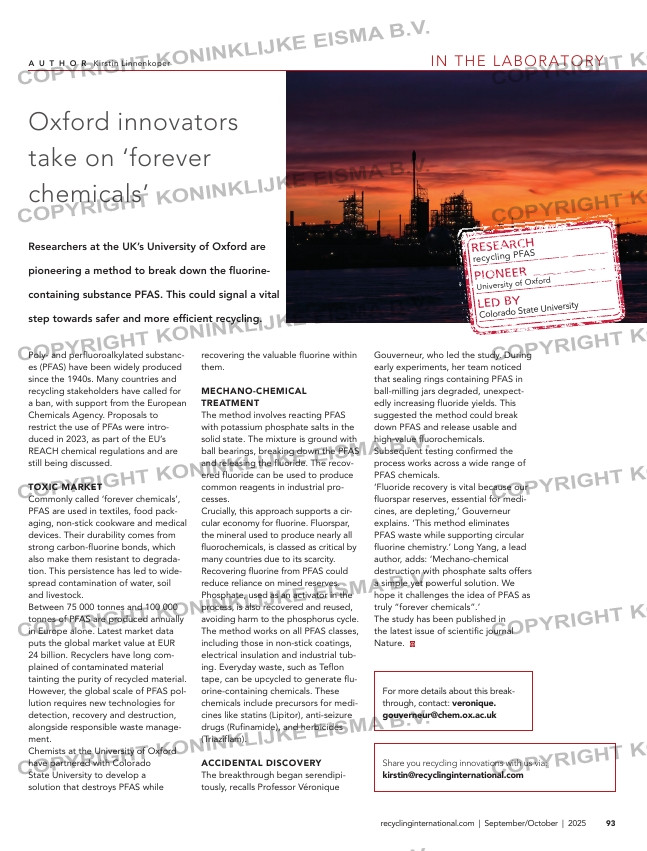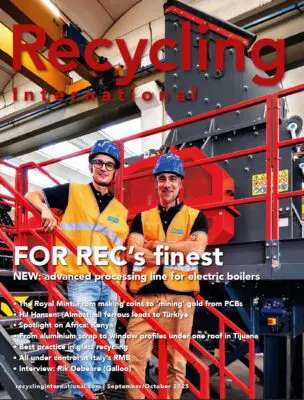Page 101 from: Recycling International September/October 2025

IN THE LABORATORY
93recyclinginternational.com | September/October | 2025
Oxford innovators
take on ‘forever
chemicals’
Researchers at the UK’s University of Oxford are
pioneering a method to break down the fluorine-
containing substance PFAS. This could signal a vital
step towards safer and more efficient recycling.
Poly- and perfluoroalkylated substanc-
es (PFAS) have been widely produced
since the 1940s. Many countries and
recycling stakeholders have called for
a ban, with support from the European
Chemicals Agency. Proposals to
restrict the use of PFAs were intro-
duced in 2023, as part of the EU’s
REACH chemical regulations and are
still being discussed.
TOXIC MARKET
Commonly called ‘forever chemicals’,
PFAS are used in textiles, food pack-
aging, non-stick cookware and medical
devices. Their durability comes from
strong carbon-fluorine bonds, which
also make them resistant to degrada-
tion. This persistence has led to wide-
spread contamination of water, soil
and livestock.
Between 75 000 tonnes and 100 000
tonnes of PFAS are produced annually
in Europe alone. Latest market data
puts the global market value at EUR
24 billion. Recyclers have long com-
plained of contaminated material
tainting the purity of recycled material.
However, the global scale of PFAS pol-
lution requires new technologies for
detection, recovery and destruction,
alongside responsible waste manage-
ment.
Chemists at the University of Oxford
have partnered with Colorado
State University to develop a
solution that destroys PFAS while
recovering the valuable fluorine within
them.
MECHANO-CHEMICAL
TREATMENT
The method involves reacting PFAS
with potassium phosphate salts in the
solid state. The mixture is ground with
ball bearings, breaking down the PFAS
and releasing the fluoride. The recov-
ered fluoride can be used to produce
common reagents in industrial pro-
cesses.
Crucially, this approach supports a cir-
cular economy for fluorine. Fluorspar,
the mineral used to produce nearly all
fluorochemicals, is classed as critical by
many countries due to its scarcity.
Recovering fluorine from PFAS could
reduce reliance on mined reserves.
Phosphate, used as an activator in the
process, is also recovered and reused,
avoiding harm to the phosphorus cycle.
The method works on all PFAS classes,
including those in non-stick coatings,
electrical insulation and industrial tub-
ing. Everyday waste, such as Teflon
tape, can be upcycled to generate flu-
orine-containing chemicals. These
chemicals include precursors for medi-
cines like statins (Lipitor), anti-seizure
drugs (Rufinamide), and herbicides
(Triaziflam).
ACCIDENTAL DISCOVERY
The breakthrough began serendipi-
tously, recalls Professor Véronique
Gouverneur, who led the study. During
early experiments, her team noticed
that sealing rings containing PFAS in
ball-milling jars degraded, unexpect-
edly increasing fluoride yields. This
suggested the method could break
down PFAS and release usable and
high-value fluorochemicals.
Subsequent testing confirmed the
process works across a wide range of
PFAS chemicals.
‘Fluoride recovery is vital because our
fluorspar reserves, essential for medi-
cines, are depleting,’ Gouverneur
explains. ‘This method eliminates
PFAS waste while supporting circular
fluorine chemistry.’ Long Yang, a lead
author, adds: ‘Mechano-chemical
destruction with phosphate salts offers
a simple yet powerful solution. We
hope it challenges the idea of PFAS as
truly “forever chemicals”.’
The study has been published in
the latest issue of scientific journal
Nature.
Share you recycling innovations with us via:
[email protected]
For more details about this break-
through, contact: veronique.
[email protected]
A U T H O R Kirstin Linnenkoper
RESEARCH
PIONEER __
_________
LED BY
recycling PFA
S
Colorado State
University
University of O
xford
93_inthelab.indd 93 09-09-2025 14:36



